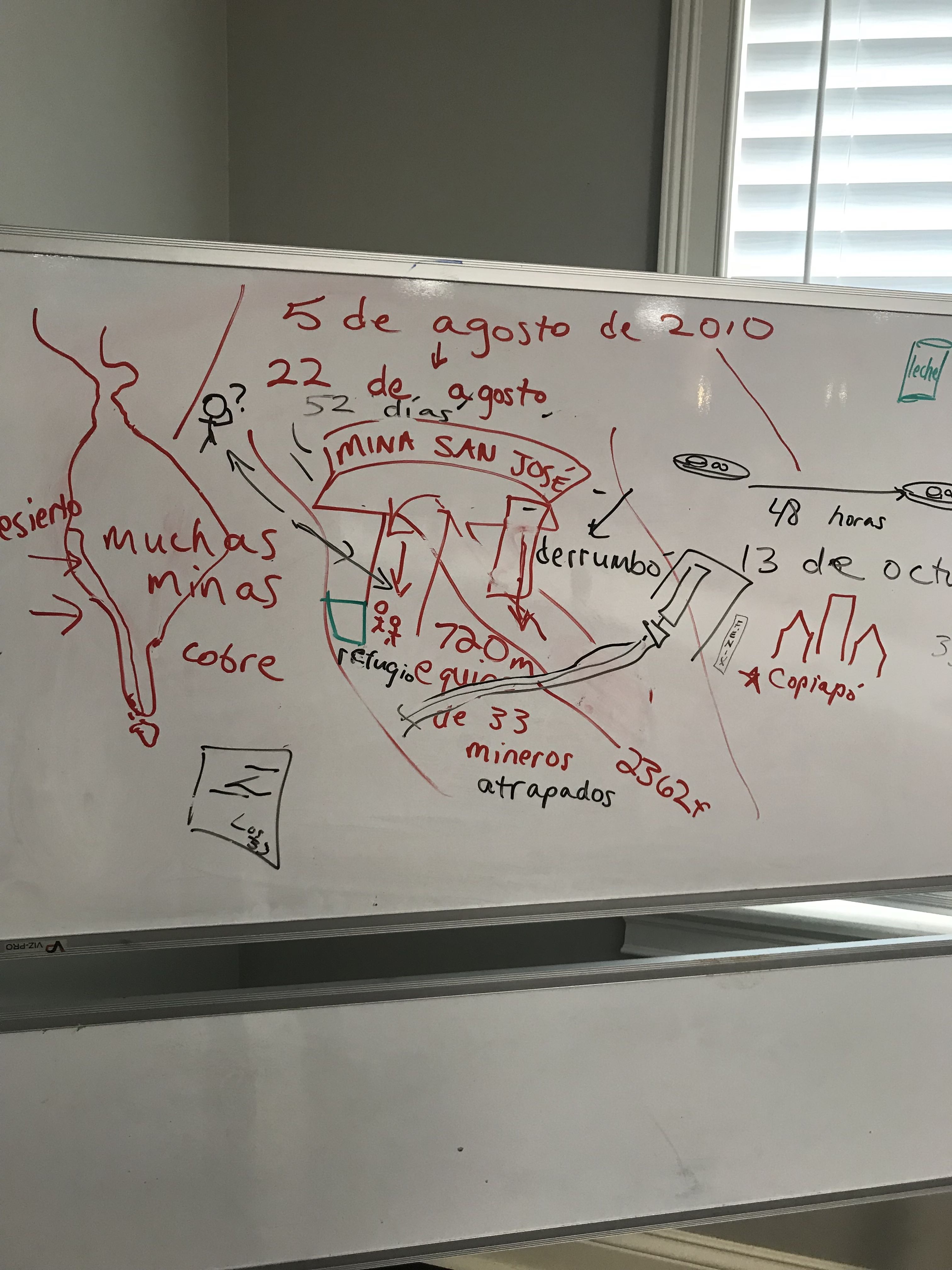And now, for the nightly news.
For students approaching or solidly sitting in Intermediate Land, a unit focused on news reporting can add some real power to world language class. Consider what pops up in the news:
- high-interest stories (engagement!)
- narration
- interviews (multiple voices!)
- culture (practices + perspectives!)
- the perfect tenses (“17 people have gotten sick after a strange school lunch mishap” – a tense that’s fairly elusive in high-interest authentic resources)
I spent half the spring semester (remember, seeing learners once a week) on a news unit, and it turned out to be a lot of fun. Several of my learners reported (haha) it was the most engaging unit last year. Thanks to some good habits I’d already developed and a session on news at the Central States conference, I landed on some powerful ways to supercharge my news unit, both to make it more fun and to make it super easy to plan. I mean super easy. Let’s talk through how you can build and pull off a more successful news unit.
Comprehensify a few very high-interest news stories
I planned my news unit to last six weeks. For the first 5 weeks, we focused on one news story each week. In the final week, learners in groups of 3 worked on doing their own newscast reports on the story they agreed was a favorite in their group.
You don’t have to write out the stories ahead of time, but it helped me break down the planning to have pre-planned what stories we were going to do. These are the stories I chose:
- The crazy fantastic 2008 rescue of a presidential candidate, 3 American military contractors, and 11 police officers from FARC in Colombia
- The crazy fantastic 2010 rescue of the 33 miners trapped underground in Chile
- The September 2017 earthquake in Mexico City and neighboring areas
- Hurricane María’s devastating hit on Puerto Rico in September 2017
- The ongoing crisis in Venezuela
The Venezuelan crisis was the longest one for me to try to distill into as few comprehensible sentences as possible, but I’m pretty proud of getting the most into only 13 sentences! So, my longest news story was 13 sentences.
Many of our regular activities were based on these sentences. If you’d like to use mine or just see them to get your own thoughts going, here’s the link to my Spanish news stories. Note: they’re written as if I’m telling the story shortly after the event happened, the way the news often does, which is why the perfect tenses come up more in news than in other contexts.
Plan regular activities with each story
If I could go back to my former new-teacher self, I’d give this advice:
Lesson planning becomes a much less life-sucking chore if you incorporate habits into it.
I did this in my AP Spanish class by giving each day of the week a theme (novel day, interpretive listening day). For the news unit, I built my lesson plans using a very similar format each week. Several of these I stole / tweaked from a session on teaching with news stories that I attended at Central States. Note how the activities below walk the continuum from receptive mode to actively using language.
- 4×2 vocabulary illustrations: In the news file I linked above, you’ll see some words/phrases are given in bold. These were target vocabulary. It was sometimes hard to narrow it to 8, but I identified the 8 key words that supported the story that I knew weren’t in my learners’ active vocabulary. Before we did anything else with the story, we established the meaning for these words. My learners took a blank unlined paper, folded it in half, and then folded it in half the other way and in half again, to create 8 rectangles on the paper. They opened the paper and filled in each rectangle with a word/phrase and an illustration of its meaning.
- The story with photos: The next thing I did was to tell the story with my comprehensible sentences. I used a combination of drawing the story and using news photos in Slides.

What the board looked like after we finished talking through the miner story - Ordering events: At this point, learners got the list of sentences but cut into strips and mixed up. They worked in teams of 3 to put the events in order.
- Match description to photo: Now, for the first time, learners have the full story in front of them in text form. I bounced around the news photos in Slides and asked: Which sentence best matches this photo? Sometimes there was more than one right answer.
- Time for 60-45-30: In that session at Central States, the college-level presenter suggested having learners retell the story to a partner in 3 minutes, then find another partner and do it in 2, then find another partner and do it in 1. If you don’t get anything else from this post, get this. My students didn’t have enough language to fill three minutes, so I turned it into 60-45-30. They told someone the story in 60 seconds, then 45, then 30. They were able to shave time as they got better, but it also made them figure out the most important parts to tell to fit in the whole story, and it made them access their implicit knowledge more by being too rushed to overthink it. I recommend this activity as a follow-up to any storytelling or reading!
- Song of the Week: Obviously, news stories use a lot of past tenses, which isn’t easy to find in volume in songs. With a bit of research (thank you Elisabeth!) I was able to find more than enough songs to fill our six weeks with at least one Song of the Week per class period. I wished we had more time for this!
We started a series of habits with our Song of the Week with our health unit and continued them here. We listened to the music and then students (in groups of three) put a specific set of lyric lines in order. Coincidentally (not), that same sequence of lines would end up being the focus of an at-home activity. I’m not going to link my lyrics file here because I’m uncertain of the copyright issues but feel free to email me if you’d like to see them.- “Consejos de amor” Tini ft. Morat
- “Si hubiera estado allí” Jesús Adrián Romero (Christian)
- “La selva negra” Maná
- “Arroyito,” Fonseca (Old post “Songs for the elusive 3rd person preterite”)
- “Nada fue un error” Coti, Paulina Rubio, Julieta Venegas
- “La historia de Juan” Juanes
And the ones we didn’t get to: “En el muelle de San Blas” by Maná, “Soy el mismo” de Prince Royce, “Bachata en Fukuoka” by Juan Luis Guerra, and “Amor con hielo” by Morat.
Plan regular activities to be completed at home
Like I said, repeated elements in plans make the planning so much easier! In addition to having activities regularly reappear in my lesson plans, the at-home activities reappeared in much the same way. In other words, learners would do the same activity but with a new story/topic/other content. Remember that I saw my learners once a week during this unit, and then they went home with, usually, at least these activities to complete the rest of the week:
- Do a flip book based on last week’s story, in which you write (in your own words) and illustrate the six most important events in the story. (To make a flip book, take 3 sheets of paper and offset them by raising each sheet about 1/2″-1″ from the next. Then, fold the sheets such that you can see the top sheet and 5 strips below it to put the sentences on. So, when you’re looking at it from the front, you see the top illustration and sentence, and then all 5 of the other sentences, but you have to open the flip book to see the next illustrations.)
(I really thought I had pictures of these but I can’t find them. This isn’t a folded version so it’s not exact but this will give you the idea of what it kind of looks like when it comes out.) - Take the 1-3 bold segments from last week’s Song of the Week and illustrate them.
- Review the Quizlet that had our news-related vocabulary.
- Answer the 5 Ws – who, what, when, where, why – to the best of your ability about a news article. I usually gave them a choice of 3-4 articles. Spanish teachers can use the 46 pages of comprehensible news offered free by Maris Hawkins or get up-to-date comprehensible news by purchasing El Mundo en tus Manos, which Maris does in collaboration with Martina Bex.
Other ideas
There are lots more things you could either do in class or assign for at-home activities, such as an Edpuzzle on an authentic news story (see this one I assigned related to the earthquake in Mexico). Other ideas that I didn’t have a chance to try would be to categorize vocabulary (which news story does this word best fit?) and backward charades with the sentence strips (see post from La Maestra Loca).
Have you thought about doing a news unit? What other ideas can you suggest?



